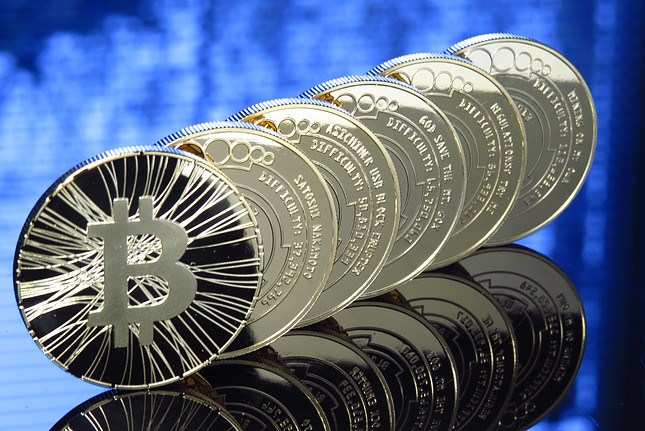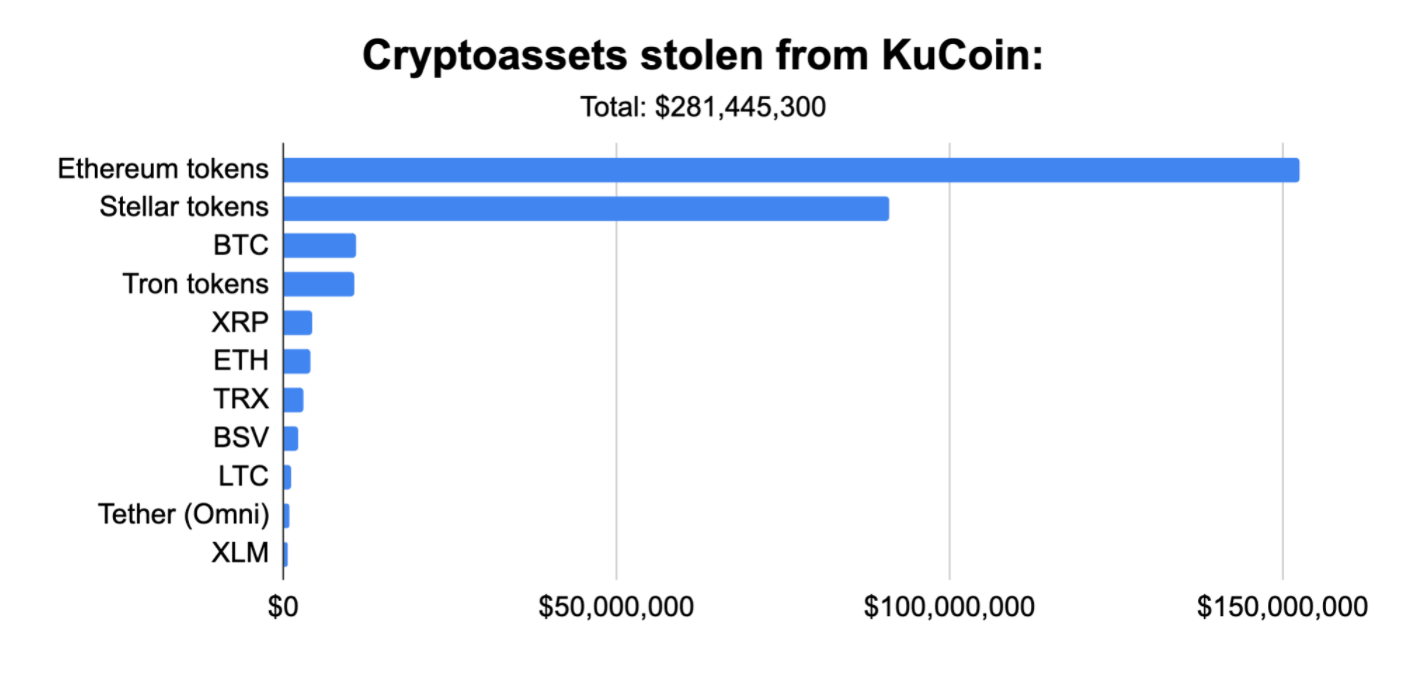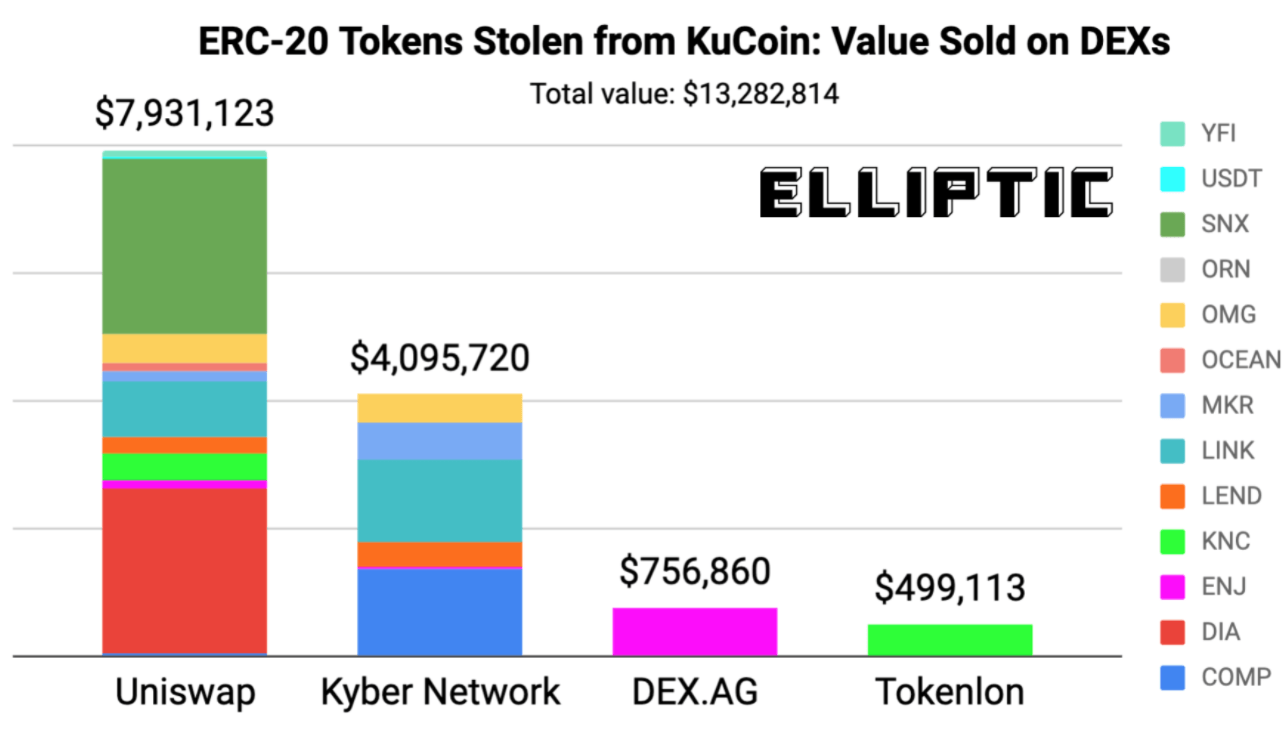- Uniswap has become a popular place for laundering stolen coins.
- Several projects appear to be less decentralized than expected.
KuCoin hack teaches us a couple of costly lessons about the decentralized finance (DeFi) industry. Some of them may become a revelation for investors.
KuCoin's story: the summary
On 25 September, an unknown hacker exploited the vulnerability of the Asia-based cryptocurrency exchange KuCoin and drained its hot wallets of $281 million in cryptocurrency assets. The episode has become the third-largest theft in the history of cryptocurrency trading platforms.
The bad guys got away with a variety of assets, including Bitcoins, Litecoin and XRP. However, ERC-20 tokens accounted for over half of the loot.
The composition of the assets stolen from KuCoin
Source: www.elliptic.co
Lesson 1: Centralized exchanges turned into a dead end
According to the data provided by Elliptic's research, the service that enables detecting and investigating risky crypto transactions, hackers attempted to sell the stolen assets on the regular exchanges. However, this route was blocked within minutes after the hack. All major trading platforms are equipped with the tools to identify where the assets originated from and freeze any accounts receiving such funds.
Centralized cryptocurrency exchanges are very cooperative and tend to prevent the money laundering through their accounts. Moreover, some of the largest trading platforms cooperate with the authorities, providing them with tools to analyze blockchains and monitor suspicious activity.
Thus Coinbase reportedly has dealt with various US authorities, including the Drug Enforcement Administration (DEA) and the Internal Revenue Service (IRS). The cryptocurrency exchange provides a cryptocurrency investigation tool called "Coinbase Analytics."
Lesson 2: DEXs turned into crypto laundromats
Meanwhile, decentralized exchanges (DEXs) provided hackers with another option to bypass the anti-money laundering procedures and cash out the stolen assets.
Unlike the centralized counterparts, DEXs are governed by smart contracts, meaning that there is no intermediary or centralized authority between the participants of the trade.
This circumstance has a couple of consequences. First, the participants stay anonymous as they do not have to disclose their identities and go through know-your-customer (KYC) processes. Second, there is no one to freeze the account to seize the funds as everything is processed automatically, based on the rules of the smart contract.
KuCoin thief benefitted from the explosive growth of decentralized exchange activity on Ethereum and began selling the stolen ERC-20 tokens on these platforms without risk of being frozen.
DEXs involved in laundering funds stole from KuCoin
Source: www.elliptic.co
As the chart above shows, the hacker focused on four DEXs, Uniswap, Kyber Network, DEX.AG and Tokenlon, and laundered about $13.3 million in coins by the time of writing. Uniswap accounts for the lion's share of this activity.
While Elliptic claims that its blockchain monitoring solutions can trace the funds on DEXs, there is still no way to block the transactions that involve the funds originated from the hack.
Lesson 3: Decentralization can be falsified
Several projects introduced the measure to lock the funds stolen by the hacker. That's what Tether did, which is hardly surprising for the community. However, several projects that deemed to be decentralized pursued a similar strategy,
For example, Ampleforth (AMPL) and Ocean Protocol (OCEAN) also took decisive action against KuCoin's bad guy.
Ocean Protocol team performed a hard fork from a few blocks before the hack to roll back the transactions. A new chain will become the main for the protocol. Basically, Ocean Protocol opted for the Ethereum's approach to the DAO hack. Read our in-depth story of what happened next.
Ampleforth team tweaked their smart contract to block the hacker's address from moving their AMPL. While this solution may look less drastic, it reveals the lack of decentralization and opens up the way to censorship. Unlike the Ocean, where users can opt for the old chain and follow the suit of Etthereum Classic, Ampleforth changed the contract unilaterally and gave the community no choice.
Kardiachain, Orion Protocol, and Aleph all have taken similar steps showing their real centralized face.
Note: All information on this page is subject to change. The use of this website constitutes acceptance of our user agreement. Please read our privacy policy and legal disclaimer. Opinions expressed at FXstreet.com are those of the individual authors and do not necessarily represent the opinion of FXstreet.com or its management. Risk Disclosure: Trading foreign exchange on margin carries a high level of risk, and may not be suitable for all investors. The high degree of leverage can work against you as well as for you. Before deciding to invest in foreign exchange you should carefully consider your investment objectives, level of experience, and risk appetite. The possibility exists that you could sustain a loss of some or all of your initial investment and therefore you should not invest money that you cannot afford to lose. You should be aware of all the risks associated with foreign exchange trading, and seek advice from an independent financial advisor if you have any doubts.
Recommended Content
Editors’ Picks

Litecoin Price Prediction: LTC tries to retake $100 resistance as miners halt sell-off
Litecoin price grazed 105 mark on Monday, rebounding 22% from the one-month low of $87 recorded during last week’s market crash. On-chain data shows sell pressure among LTC miners has subsided. Is the bottom in?

Bitcoin fails to recover as Metaplanet buys the dip
Bitcoin price struggles around $95,000 after erasing gains from Friday’s relief rally over the weekend. Bitcoin’s weekly price chart posts the first major decline since President-elect Donald Trump’s win in November.

SEC Commissioner Hester Pierce sheds light on Ethereum ETF staking under new administration
In a Friday interview with Coinage, SEC Commissioner Hester Peirce discussed her optimism about upcoming regulatory changes as the agency transitions to new leadership under President Trump’s pick for new Chair, Paul Atkins.

Bitcoin dives 3% from its recent all-time high, is this the cycle top?
Bitcoin investors panicked after the Fed's hawkish rate cut decision, hitting the market with high selling pressure. Bitcoin's four-year market cycle pattern indicates that the recent correction could be temporary.

Bitcoin: 2025 outlook brightens on expectations of US pro-crypto policy
Bitcoin price has surged more than 140% in 2024, reaching the $100K milestone in early December. The rally was driven by the launch of Bitcoin Spot ETFs in January and the reduced supply following the fourth halving event in April.

Best Forex Brokers with Low Spreads
VERIFIED Low spreads are crucial for reducing trading costs. Explore top Forex brokers offering competitive spreads and high leverage. Compare options for EUR/USD, GBP/USD, USD/JPY, and Gold.

